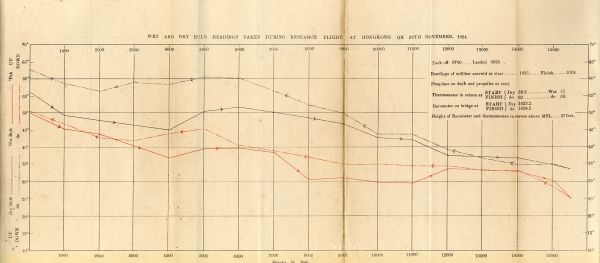Aircraft weather observations now automatic
Aircraft weather observations now automatic (6 May 2004)
|
Aviation weather services in Hong Kong have entered a new era as the Hong Kong Observatory started reception of automatic weather reports from computers on commercial aircraft in April 2004. Hong Kong It has been 80 years since the Observatory started collecting meteorological data from aircraft. Back in 1924, two Flying Officers from the Royal Navy of United Kingdom visited the Observatory and furnished copies of temperature readings made during four flights over Hong Kong (Picture 1). This was the first time the Observatory received aircraft weather observations over Hong Kong and it took weeks for the information to arrive. Through the collaboration between the Observatory, Cathay Pacific Airways and the Civil Aviation Department (Picture 2), aircraft weather reports are now automatically transmitted to the Observatory via computer links. This new means obviates the need for manual on-board transmission and ground reception of reports, greatly reducing the workload and possibility of human error. As compared with the first weather reports in 1924, these automatic ones are bigger in number and cover a much wider geographical area. In addition, the weather reports are delivered to the aviation weather forecaster within minutes instead of weeks after the measurements are made. At present, the Observatory receives about 300 weather observations daily directly from aircraft travelling between Hong Kong and other airports around the world (Figure 3). These contain information on wind Apart from the Observatory, meteorological centres serving other aviation hubs are also receiving automatic aircraft reports through partnership of major airlines under a World Meteorological Organization programme "We hope to further develop the programme to obtain more aircraft weather observations in the future and provide even more reliable and effective aviation weather services," said Mr H G Wai, Acting Assistant Picture 1:Picture shows the temperature readings collected by two Flying Officers from the United Kingdom during their flights over Hong Kong in 1924. Picture 2: Picture shows the Hong Kong Observatory, in collaboration with Cathay Pacific Airways and Civil Aviation Department, receiving automatic weather observations from a B-747 commercial aircraft. Picture3: Picture shows weather observations received from an aircraft departing Hong Kong on April 2, 2004. |


